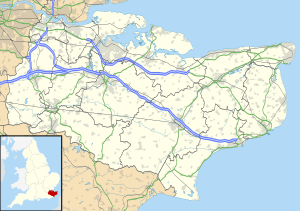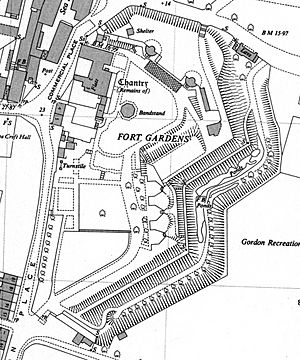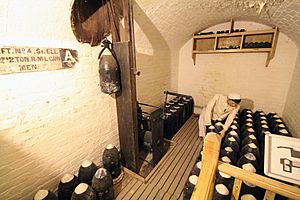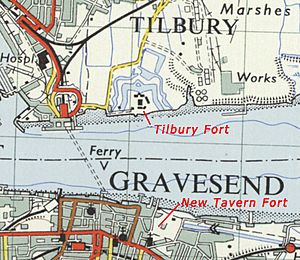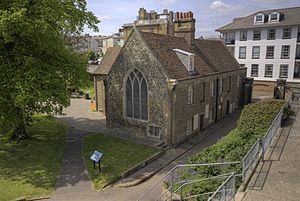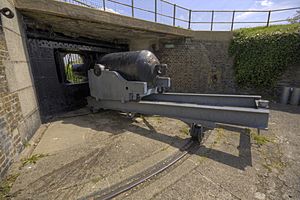New Tavern Fort facts for kids
Quick facts for kids New Tavern Fort |
|
|---|---|
| Gravesend, Kent | |
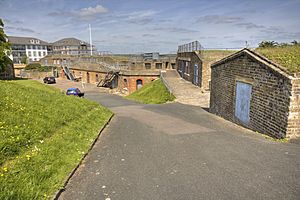
Ramparts and emplacements at New Tavern Fort
|
|
| Coordinates | 51°26′37″N 0°22′36″E / 51.443626°N 0.376782°E |
| Type | Fortification |
| Site information | |
| Controlled by | Gravesham Borough Council |
| Open to the public |
Yes |
| Condition | Interior buildings mostly demolished, emplacements and magazines preserved |
| Site history | |
| Built | ca. 1780–83 |
| Built by | United Kingdom |
| In use | ca. 1780–1950s |
| Materials | Earth, brick, concrete |
New Tavern Fort is an old artillery fort in Gravesend, Kent. Most of it was built in the 1700s and 1800s. It's a great example of an 18th-century fort that is still in good shape. The fort was used to defend the area until World War II.
It was first built during the American War of Independence to protect the River Thames. The fort guarded against French and Spanish ships helping the new United States. Later, in the mid-1800s, it was rebuilt to fight against new, strong French warships made of iron.
By the early 1900s, the Thames defenses moved further down the river. The fort's guns were removed. The land around it became a public park with gardens. But during World War II, the fort was used by the military again for a short time. Today, you can visit the fort, its underground rooms, and old gun areas. It's special because it shows guns and defenses from the 1700s all the way to the 1900s.
Contents
Exploring the Fort's Walls and Gun Areas
The fort sits on the south side of the River Thames. It was built to work with the older Tilbury Fort on the north side. The fort has wide, zig-zagging earth walls called ramparts. In front of these walls is a wide ditch.
Inside the ramparts are eight gun positions, called emplacements. Six are made of brick, and two are made of concrete. Underneath these emplacements are storage rooms for ammunition. The middle of the fort used to be a parade ground. Now it's a grassy lawn with flowers, trees, and a bandstand.
The ramparts face the river and have three main parts.
Northern Gun Positions
The northern part of the fort used to be called the North Face. It has two concrete gun positions shaped like half-circles. In 1904, two large 6-inch guns were placed here. The fort still has guns like these, though they are not the originals. This makes New Tavern Fort the only place in the UK with a complete two-gun battery of this type. A concrete spot for aiming guns is nearby, and you can still see where its instrument pillar stood.
Middle Gun Positions
The middle part of the north rampart was once called the Garden Face. It was close to the fort's gardens. This section has four brick gun positions built between 1868 and 1872. These held special guns called rifled muzzle loaders (RMLs).
One gun position has a thick iron shield with a hole for the gun. The other three are open. All four are very well-preserved. You can still see the rails that helped the guns move. Doors on each side lead to shafts where ammunition was brought up from the storage rooms below. The shielded gun position now has an RML gun, looking just as it did long ago.
Southern Gun Positions
The southern part of the rampart was known as the East Face. It faces the river. This area has two small brick gun positions built in the 1860s. They once held guns that could turn to fire in different directions.
Secret Tunnels and Storage Rooms
The entrance to the fort's storage rooms, called magazines, is in the middle rampart. It leads to a 600-foot-long, 4-foot-wide brick tunnel. This tunnel zig-zags under the rampart.
Along the tunnel are sixteen smaller storage rooms. These were used to hold cartridges and shells. Lifts connected these rooms to the gun positions above. The main magazine had two large rooms for cartridges and shells. Ammunition was moved from here along the tunnel to the smaller rooms.
To prevent sparks and explosions, special safety lights were used behind glass screens. Workers in the magazine wore special slippers and clothes. This made sure they wouldn't create any sparks while moving around.
Today, some of the magazines have been fixed up. They show how they were used and tell about Gravesend's military past. You can visit them on summer weekends. Another brick-arched magazine is under the north rampart. It stored ammunition for the 6-inch guns and fire equipment.
A wide ditch sits in front of the ramparts. It was made wider in the 1860s and once had a fence to stop enemy soldiers. Now, it's filled with plants, small ponds, and paths. It's a lovely nature area.
Most of the fort's original buildings, like barracks, are gone. The only old building left is the medieval Milton Chantry. This is the oldest building in Gravesend and was used as barracks.
Why Was This Fort Built?
The lower part of the River Thames was very important for defense. It had big military places like the dockyard at Woolwich and the arsenal at Purfleet. It was also vital to stop enemies from landing along the Thames, which could lead them to London. The crossing between Gravesend and Tilbury was also key. This is why forts were built on both sides of the river there long ago.
New Tavern Fort was built because of a threat from Britain's enemies during the American War of Independence. These enemies included the new United States and its friends, France and Spain. In 1778, an American adventurer named John Paul Jones attacked Whitehaven. This showed that Britain's coastal defenses were weak. His actions and a failed French-Spanish invasion in 1779 made the British government check its defenses. They found many problems and planned to build 30 new forts along the southern and eastern English coast.
An engineer named Thomas Hyde Page checked the Thames area. He suggested fixing up the old Tilbury Fort and building a new fort. This new fort would replace an older one in Gravesend. The new fort would be 250 meters east of the old one. This spot would let its guns reach further downriver and work with Tilbury Fort. With fears of a French invasion growing, the government approved the plans, and building started soon after.
Building the Fort: A Look Back
The fort was built between 1780 and 1783. It was on land where the New Tavern Inn once stood, which is how it got its name. The land was bought from its owner. At first, it was an uneven earthwork with two gun batteries connected by a wall. The first battery had two sides facing the river. The second, smaller battery had a straight front. A ditch with a 3-meter-high wooden fence protected the river side. The two batteries had fifteen heavy guns that fired through openings.
Milton Chantry became part of the fort and was used as barracks for soldiers. By the 1790s, more buildings were added, like officer quarters and stables. The back of the fort was open at first. But by the late 1700s, a defense wall with holes for muskets was built to close it off. A special oven was also built to heat cannonballs red-hot. These hot cannonballs could set enemy ships on fire.
Upgrading the Fort: New Guns and Defenses
New Tavern Fort was rebuilt many times in the 1800s. But its basic shape and earth walls stayed the same. In 1848, the gun positions were updated for guns that could turn. More ammunition storage rooms were also built.
Soon, more upgrades were needed. By the late 1850s, Britain and France were in a race to build better warships. New ironclad ships, like Britain's HMS Warrior and France's La Gloire, had powerful new guns. These ships were a big threat to existing forts. So, the British government created a group to review defenses. They said the Thames was important but easy to attack from the sea. They suggested two main lines of defense for the Thames. New forts like Shornemead Fort and Cliffe Fort in Kent, and Coalhouse Fort in Essex, would form an outer defense line. Tilbury Fort and New Tavern Fort would be the inner line.
Before these plans were fully carried out, the fort got new guns. In 1859, its old guns were replaced with ten 68-pounder guns. These were very powerful and could shoot up to 3,500 yards. By 1865, two of these were replaced with 10-inch shell guns, and an 8-inch shell gun was added. In 1862, four early breech-loading guns replaced the older movable guns.
The Army first focused on the outer forts. It wasn't until 1868 that orders came to rebuild Tilbury and New Tavern Forts. The old magazines and walls were torn down. New brick gun positions were built. These held ten 9-inch and one 12-inch RML guns, which could shoot up to 4,600 yards. Seven of these gun positions had iron shields. The ramparts were changed a lot to make room for new magazines. These magazines were connected by lifts to serving rooms near the guns. Colonel Charles George Gordon, who later became famous, lived near the fort from 1865 to 1871 while he oversaw this project.
The Fort in Modern Times
By the early 1900s, the fort was not as important. Naval guns had become much stronger. The main defense line for the Thames moved further downriver. Bigger guns there could control the entire river mouth. The old RML guns were outdated. The fort's gun positions offered little protection against modern naval attacks. An 1887-8 report said the fort's "guns are crowded" and needed changes.
In 1905, the RML gun positions were replaced with two concrete pits for 6-inch guns. These new guns could shoot 6 miles. New magazines were built for them. These guns were only there for a few years. The fort's guns were removed before World War I started in 1914. In 1930, it got two replacement 6-inch guns. These were used to train soldiers. At the same time, the local council bought the inside of the fort. In 1932, the fort's interior opened to the public as a pleasure garden. The gun battery was still used until 1938. Some of the fort's inside buildings were also taken down then.
Even without guns, New Tavern Fort was used during World War II. Two 20-meter-high radio masts were built on top of the old magazines. These supported a naval radio station. People say this station listened to enemy radio messages. These messages were then sent to Bletchley Park to be decoded. In 1941, the Navy used the magazines and tunnels as air raid shelters for a nearby naval base.
After the war, the fort became a garden again. Fort House, where the commanding officer lived, was badly damaged by a V-2 rocket in 1944 and had to be torn down. Part of Milton Chantry was also demolished in 1948. The Chantry's chapel was used as a local history museum from 1953 to 1970. In 1969, most of the rest of the Chantry was demolished. The remaining part became a heritage center in 1972.
Visiting New Tavern Fort Today
Today, the fort is part of Gravesham Borough Council's Riverside Leisure Area. The outdoor parts are open all year. A local heritage group opens the restored magazines on summer weekends. Restoration work began in 1975. In 1977, the fort was given a special Grade II* listing. This means it's an important historic building because it's such a complete example of a fort.
Two 6-inch guns were put back in the fort in the 1980s. This makes it the only fully armed two-gun battery of its kind in mainland UK. The magazines have also been restored and equipped in a way that is unique in the UK. The fort's collection of guns and gun positions from the 1700s to the 1900s is also very special.


